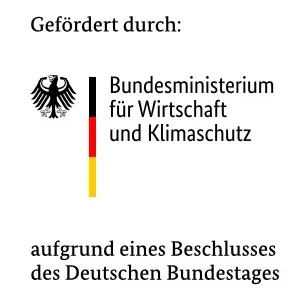Prostate cancer working group
Current projects: CLINIC 5.1 Comprehensive Lifesciences Neural Information Computing - outcome-oriented patient treatment through AI-defined interventions with the virtual patient in 4D

[autotranslated from German content]
With an incidence of 23.2%, prostate cancer is the most common malignant tumor disease in men in Europe according to ECIS (European Cancer Information System, data from 2020). Prevention, diagnosis and treatment have made considerable progress in recent years and have shown the high added value of interdisciplinary research projects in this field. However, it is also very clear how complex the path through the individual stages from initial suspicion, diagnosis, treatment decision and aftercare is for the patient, but also for the doctors involved from different disciplines.
CLINIC 5.1 (Comprehensive Lifesciences Neural Information Computing - outcome-oriented patient treatment through AI-defined interventions with the virtual patient in 4D) addresses this point and brings together experts from clinics, research and industry. With the help of new AI-supported methods and the integration of diagnosis and therapy-relevant data into a uniform data environment, a digital twin of a prostate patient is being created as part of CLINIC 5.1 in order to enable targeted decision support and thus personalized treatment of the patient. With this proof-of-concept study, the CLINIC 5.1 consortium aims to use the digital twin to map the patient's journey through the individual stages, from diagnosis to treatment and aftercare, and also to open up the possibility of analyzing and correlating the data collected and evaluated by doctors in this context using state-of-the-art AI algorithms. With the help of the digital twin, the various treatment options and the associated risks and chances of success can be determined individually for each patient. In this way, doctors can be significantly supported in the complex decision-making process. https://clinic51.de/
As part of CLINIC 5.1, the "Intelligent Pattern Recognition/MultiOmics" sub-project is being carried out in the Radiology Division at the German Cancer Research Center (DKFZ). In this work package, technical approaches for intelligent pattern recognition on medical image data are being implemented and tested in the application domain of prostate MRI. The aim is to develop an annotation platform that radiologists can use to analyze diagnostic findings. The annotation platform enables a systematic evaluation of image data, the collection of quantifiable diagnostic parameters and the curation of image and clinical data. On the other hand, the DKFZ is applying the latest approaches in computer-based medical image processing to the problem of diagnosing clinically significant prostate cancer, using radiomics and deep learning in particular. To this end, a demonstrator application is being developed that can make predictions based on individual imaging examinations. At the integrative and MultiOmics level, MRI image data will be linked with image data from digital pathology as well as with demographic, clinical and MultiOmics data available in CLINIC 5.1 in close cooperation with the Urological University Hospital Heidelberg and the Division of Applied Tumor Biology at the Institute of Pathology at Heidelberg University Hospital in order to develop optimized and flexible prediction models and compare them with existing risk models.
CLINIC 5.1 is funded by the Federal Ministry of Economics and Climate Protection (BMWK) as a strategic individual project in the field of "Development of digital technologies".
Consortium partners:
- German Cancer Research Center (DKFZ)
- Drägerwerk AG & Co. KgaA (associated)
- KARL STORZ SE & Co. KG
- mbits imaging GmbH (associated)
- SAP SE
- Siemens Healthineers AG
- Heidelberg University, Institute of Physics
- Heidelberg University Hospital
- University Medical Center Mannheim, Clinic for Radiology and Nuclear Medicine (associated)
Network coordinator:
Heidelberg University Hospital
Im Neuenheimer Feld 420
69120 Heidelberg
Project duration: March 2021 - August 2023
Contact subproject Intelligent Pattern Recognition/MultiOmics (AP6):
Prof. Dr. med. David Bonekamp
Division of Radiology/E010
German Cancer Research Center
(Kopie 1)

MR-TULSA (MRI-Guided Transurethral Ultrasound Ablation of the Prostate using Real-Time Thermal Mapping)
Contact: Bonekamp/Hatiboglu
Magnetic resonance imaging-guided transurethral ultrasound ablation (MRI-TULSA)(1, 2) is a novel minimally invasive technology for ablating prostate tissue, potentially offering good disease control of localized cancer and low morbidity. The department of radiology at the DKFZ was one of the three major sites in the phase 1 study which was performed between March 2013 and March 2014. The objective of the phase 1 study was to determine the clinical safety and feasibility of MRI-TULSA for whole-gland prostate ablation in a primary treatment setting of localized prostate cancer (PCa). MRI-TULSA was feasible, safe, and technically precise for whole-gland prostate ablation in patients with localized PCa. Phase 1 data were sufficiently compelling to study MRI-TULSA further in a larger prospective trial with reduced safety margins, which began in December 2016 and is currently (March 2017) ongoing.
Ion Prostate Irradiation (IPI)
Contact: Bonekamp/Müller-Wolf
The Ion Prostate Irradiation (IPI) study is a phase-II prospective, randomized trial to evaluate safety and feasibility of primary hypofractionated proton and carbon ion irradiation of PCa patients using an active raster scan technique (3). In the time period between March 2012 and October 2013, a total of 92 patients with biopsy- proven PCa were included. The 18-month follow-up was completed in June 2015. The precise monitoring of treatment changes with multiparametric MRI during this novel form of treatment has led to new insights into the pathophysiology of prostate cancer which will be useful for further development of imaging biomarkers (4, 5). A follow-up study is currently in the planning phase.
Selected Publications
1. Chin JL, Billia M, Relle J, Roethke MC, Popeneciu IV, Kuru TH, Hatiboglu G, Mueller-Wolf MB, Motsch J, Romagnoli C, Kassam Z, Harle CC, Hafron J, Nandalur KR, Chronik BA, Burtnyk M, Schlemmer HP, Pahernik S. Magnetic Resonance Imaging-Guided Transurethral Ultrasound Ablation of Prostate Tissue in Patients with Localized Prostate Cancer: A Prospective Phase 1 Clinical Trial. European urology. 2016;70(3):447-55.
2. Mueller-Wolf M, Röthke M, Hadaschik B, Pahernik S, Chin J, Relle J, Burtnyk M, Dubler S, Motsch J, Hohenfellner M, Schlemmer HP, Bonekamp D. Transurethral MR-Thermometry Guided Ultrasound Ablation of the Prostate–The Heidelberg Experience During Phase I of the TULSA-PRO Device Trial. MAGNETOM Flash. 2016;66(3):130-7.
3. Habl G, Hatiboglu G, Edler L, Uhl M, Krause S, Roethke M, Schlemmer HP, Hadaschik B, Debus J, Herfarth K. Ion Prostate Irradiation (IPI) - a pilot study to establish the safety and feasibility of primary hypofractionated irradiation of the prostate with protons and carbon ions in a raster scan technique. BMC cancer. 2014;14:202.
4. Wolf MB, Edler C, Tichy D, Rothke MC, Schlemmer HP, Herfarth K, Bonekamp D. Diffusion-weighted MRI treatment monitoring of primary hypofractionated proton and carbon ion prostate cancer irradiation using raster scan technique. Journal of magnetic resonance imaging : JMRI. 2017.
5. Bonekamp D, Wolf MB, Edler C, Katayama S, Schlemmer HP, Herfarth K, Rothke M. Dynamic contrast enhanced MRI monitoring of primary proton and carbon ion irradiation of prostate cancer using a novel hypofractionated raster scan technique. Radiotherapy and oncology : journal of the European Society for Therapeutic Radiology and Oncology. 2016;120(2):313-9.
https://www.ncbi.nlm.nih.gov/pubmed/?term=bonekamp+d